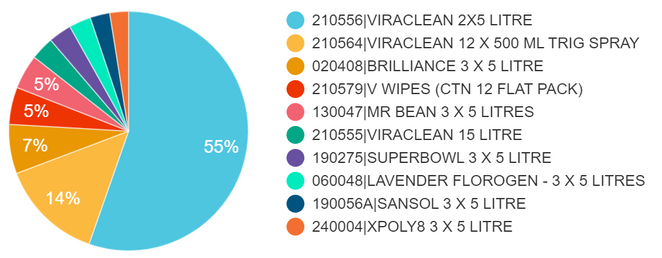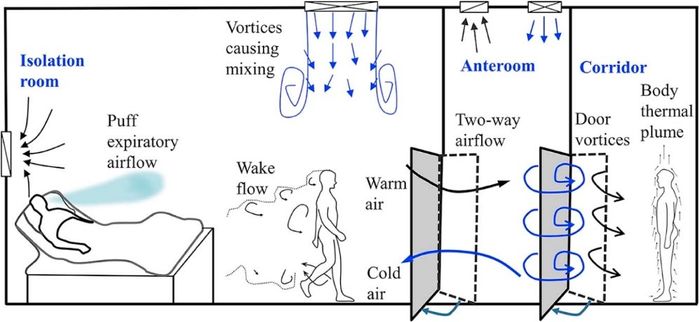I hope you and your families are well. At long last it seems that the big re-opening is almost here. It’s an exciting development, considering the frustration of mass lockdowns and the financial pain that accompanies them. I sincerely hope that October sees us head back to normality and that Q4 is the best quarter of the year for all of us.
September
September revenue across the sector was down from August. Sales of disinfectants remained buoyant. It was interesting to see TGA-registered hospital grade products in higher demand in the corporate and commercial space. Floorcare and Bathroom products did particularly well, which may be an indicator that the hospitality and retail sectors are preparing to open. The Top 10 Whiteley products across NSW and Tasmania in September were:
In other news….
Cleaning Hard Floors
Last month we discussed two studies that clearly showed how germs on floors become mobile. Koganti (Infection Control & Hospital Epidemiology, 2016) showed that a virus placed on a hospital floor had migrated to different areas within 24 hours. Wei (American Journal of Infection Control, 2016) demonstrated how floor germs follow us around in little thermal plumes then land on higher surfaces when we stop walking.
We concluded that a sealed floor is easier to keep clean. There are many products available to seal floors. The Whiteley range includes the following:
- IMPACT®. A very hard, fairly glossy base coat for all surfaces.
- THERMAGLO PLUS®. A general, user-friendly glossy sealer that can be buffed with a slow speed machine. It has the highest anti-slip rating on the market.
- BRILLIANCE®. A high gloss top-coat sealer that is scuff-resistant. Requires monthly maintenance with REJUVEN8®.
- SYNERGY®. A very high-gloss sealer but the trade-off for it’s wet-look finish is that it’s slightly softer and not so scuff-resistant. Requires weekly maintenance with REJUVEN8®.
- PROTECT®. An invisible/matte sealer for outdoor areas, tiles, concrete, bricks and sandstone. Not slippery so it’s great on driveways. Good for repelling graffiti.
Cleaning and Disinfecting Carpets
Carpets are very effective at accumulating soil. If you placed a carpet square under a microscope you’d see dust, dust mites, dead skin cells, insect remains, insect faeces, bacteria, mould and allergens clinging to the fibres. The three accepted methods for cleaning carpet are:
- Dry Vacuum – using a vacuum cleaner to suck out loose debris.
- Encapsulation – spraying a crystallising liquid that is brushed in. It envelopes or encapsulates the soil, dries as a powder, and is vacuumed out.
- Extraction – infusing a detergent solution under high pressure, which dislodges deep soil. The dirty water is and vacuumed up. Takes several hours to dry but gives the deepest clean.
Can carpet be disinfected? Not really. Not according to the hospital definition of disinfection, which is to “eliminate the germs on a surface.” Carpet is a porous substrate, which means germs have many places to hide. But we can certainly sanitise it, which means “to reduce germs to a safe level” by using a disinfectant. The more powerful the disinfectant used, the greater the sanitising effect. If you want to disinfect a carpet, perform a deep clean (extraction method) first. Then while the carpet is still wet, spray a disinfectant of your choice over the entire area. A pump-up garden sprayer works perfectly well. Use VIRACLEAN® for healthcare areas. For commercial and retail carpets, use LEMON DISINFECTANT® or PEACH DISINFECTANT®.
Whiteley carpet detergents do not contain added fragrances. That means if you spray a deodoriser or disinfectant after cleaning with FABRIPOWR®, there will be no clash of perfumes. Perfume clash (from say, a floral detergent and a citrus disinfectant) can create a confusing synthetic stink.
Here are the steps for properly cleaning and sanitising carpet:
Step 1: Remove Loose Debris
- Vacuum
- In public areas, use a vacuum with a high-efficiency particulate air (HEPA) filter. If it’s a healthcare environment, ensure there are no patients in the room
- Spot stains using FABRISOLV®
Step 2: Deep Clean
- Pre-spray with FABRIPOWR® detergent and allow the product to dwell to loosen soil. FABRIPOWR® has no added perfume
- Agitate using a vertical counter-rotating, dual or triple brush machine while damp
- Use a carpet extraction machine to simultaneously inject clean water and extract soiled wastewater
- If you can’t afford several hours drying time, perform an encapsulation clean. Use ENCAPSUL8®, let it dry to a powder, and vacuum the dry residue
Step 3: Sanitise
- While carpet is still damp from the extraction, apply a disinfectant. Options include VIRACLEAN®, PEACH DISINFECTANT®, LEMON DISINFECTANT® and MR BEAN®
- Allow the carpet to dry without supplemental blowers, which may prematurely dry the carpet before the appropriate dwell time is reached
- If the risk of infection is low, don’t bother with a disinfectant at all. Use a deodoriser like FLOROGEN® or VANILLA BREEZE® and choose your favourite scent
And so ends Q4! If you need any additional support, feel free to contact us! In the meantime, have a fantastic October.


